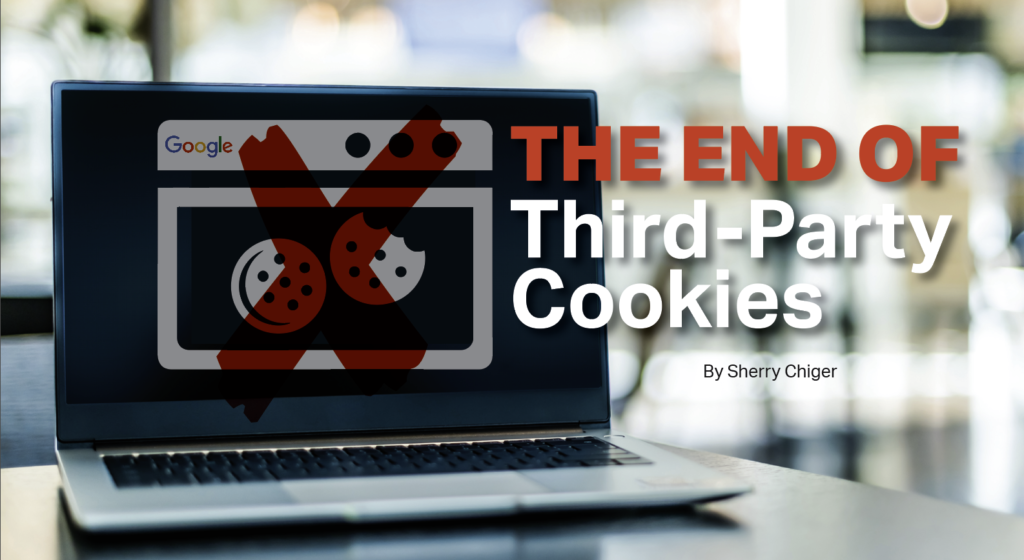The End of Third-Party Cookies
When Google announced in January 2020 that it would stop supporting third-party cookies by the end of 2022, marketers began scrambling to understand how this would affect them—or at least, they did until COVID-19 hit. By spring 2020, the pandemic had pushed just about everything else, including third-party cookie deprecation, way down the list of things to be concerned about. And when Google announced in June 2021 a one-year postponement of its cookie deprecation to the end of 2023, many marketers continued to relegate the issue to the proverbial back burner.

“But the smart players won’t take this as a signal to relax and slow down,” says Mollie Spilman, Chief Revenue Officer for Oracle Advertising and Marketing. “We all need to keep up the pace together to meet business needs while addressing consumer demand for more data privacy, transparency, and control.” In other words, ignore the impending “cookie-pocalypse” at your own risk.
DETERMINE WHAT YOUR DATA’S WORTH
Many people toss around terms such as third-party cookies and first-party data without truly understanding what they mean. Here’s a primer:
• Zero-party data is info that an individual explicitly provides. When someone inputs his email address so that he can receive your newsletter, that address is zero-party data.
• First-party data is information you have gathered passively about someone who has interacted with your website, apps, or other platforms that belong to you. Purchase history, email-to-website click-throughs, and browsing behavior on your e-commerce site are examples of first-party data. When discussing first-party data, many people lump zero-party data in with it.
• Second-party data is a trusted partner’s zero- and first-party data that you’ve purchased or negotiated the rights to use. Ideally, the partner has a strong affinity with your business.
• Third-party data is information collected indirectly by an outside organization. Pre-internet, it included information aggregated via census records, phone books, and the like. Now it usually refers to information that an online platform, publisher, or aggregator gathers passively, using technology such as cookies to track individuals’ web-behavior. Third-party cookies are what have enabled retargeting ads, prospecting via social media and other online platforms, and other types of performance marketing to be so profitable for online advertisers and publishers alike.

COOKIES AND OTHER BROWSERS
At least two other web browsers, Firefox and Safari, have already blocked the use of third-party cookies. But according to web stats provider W3Counter, while Safari has 15 percent of the global web browser market share and Firefox less than 3 percent, Google Chrome owns nearly 72 percent of the market. Add to that Google’s dominance in online search, and it’s clear why its decision to stop supporting third-party cookies will have a significant impact on marketers.
Or at least on some marketers. Eric Schmitt, Research Director, and Analyst at Gartner, notes that some businesses “are in decent shape because they didn’t have much exposure to performance marketing to begin with—multinationals, CPG companies, automotive brands. Local businesses are protected as well.”
Retailers and other direct-to-consumer businesses, however—“anyone who relies on performance spend,” says Schmitt—should be addressing the upcoming deprecation now.
The first step: determining just how important your existing performance marketing campaigns are to your company’s top and bottom lines. “You need to really stress test your programmatic ad spend,” Schmitt says. “There are issues of fraud. There are questions of the effectiveness of banner ads overall. Try to establish how important these are to your overall business before moving heaven and earth to find alternatives.” When assessing how much of your media spend and subsequent revenue are related to third-party cookies, consider halting performance marketing campaigns in one or several markets to measure the effect.
Once you’ve quantified the potential impact of third-party cookie deprecation on your business, “inform and educate the CEO and other business stakeholders,” Schmitt says. “File this under self-preservation.” The earlier you can reset organizational expectations, the better—for you and the business.
“MOTHERHOOD, APPLE PIE, AND FIRST-PARTY DATA”
“Prioritize first-party data” has become the advice given most frequently to marketers trying to wean themselves from third-party cookies. “It’s become motherhood, apple pie, and first-party data,” Schmitt jokes. Of course, marketers have long known the importance of collecting, storing, and using data garnered from their own customers, website visitors, and opt-in subscribers. But for direct-to-consumer businesses especially, relying on third-party cookies has been much easier and more affordable.
Fortunately, businesses might be pleasantly surprised by just how much zero-party and first-party data they already have at their disposal. “Whether it is purchase and loyalty information, email opt-ins, online log-ins, or direct mail, effective marketers are using tools to onboard their data for digital activation,” Spilman notes.
“Go through every department in the organization and see your data,” advises Hugo Loriot, a partner at global martech consultancy 55. “Most people think only of website data, but you should look at where other types of personal data live, such as sweepstakes data, events, information from people who have scanned QR codes on products.” Don’t forget the data garnered from your customer service department and warranties, as well as data housed by your vendors. “The more data you have for your analysis now, the better,” Loriot says. “Marketers should get their data from their tech vendors in their own environments now.
GET STARTED WITH DATA COLLECTION
If you don’t already have effective means of collecting zero- and first-party data, waste no time in implementing a few. You might consider the following low-tech options:
• Email and SMS opt-ins – Just about every one of your touchpoints, online and offline, should include an invitation to opt-in. Many businesses reward those who sign up with a discount on their first purchase, for instance or a free white paper.
• Content marketing – Giving someone who volunteers information a free white paper or guide is one type of content marketing. Quizzes are another. Or you could make your company’s blog or the resource portion of your website gated so that people need to provide some personal information before they can access the content there.
• Questionnaires – Asking those who have opted in for relevant (but not intrusive) information can add valuable first-party data to your zero-party information. Make it clear how customers and prospects will benefit from supplying this info to you (“This will allow us to personalize your user experience,” for instance), and ask only for information that you truly intend to use.
• Sweepstakes and contests – Again, people will provide their name, email address, and even a bit of demographic information for a chance to win something.
• Loyalty programs – Not only do loyalty programs encourage customer loyalty and brand engagement, but many people happily volunteer valuable demographic and psychographic information in exchange for discounts, points, or other benefits.
• “Share with a friend” links and “refer a friend” promotions – Often people will trust the word of their friends more than that of an ad. Referral incentives can drive interactions and expand your customer base while garnering valuable info.
• Customer feedback and reviews – Such information helps you hone your product and service offerings, of course. But if you can link each review back to the individual in your database, you can append that information to the customer’s profile as well.
KEEP IT CLEAN
The value of first-party data is obvious: it’s yours, it comes from people who have chosen to interact with you and therefore are prequalified to at least some degree, and it includes behavioral or demographic information so that you can better target your offering to these individuals. But first-party data also enables you to create look-alikes for prospecting. “Knowing who your customers are or who your most recent customers are giving you insight into how to find more people like them,” Schmitt says.

Enter data clean rooms. If you’re not clear on what a data-clean room is, you’re not alone. “It’s become a buzzword, and everyone’s defining it a little differently,” Schmitt says. Basically, a data clean room is an environment where marketers, publishers, and other owners of first-party data can bring and securely share that anonymized data. The data from both partners is aggregated, matched, and analyzed. Personally identifiable information (PII) is encrypted so that it is readable only by the technology; you would not know whether the Jane Doe who spent $1,000 with your company is the same Jane Doe who spent $2,000 with your partner, but the analytics program would. You cannot glean any PII regarding your partner’s customers that would allow you to reach out to those individuals directly, and vice versa.
If you wanted to target look-alikes of your best customers among the users of a large publisher such as Google or Amazon, you’d share your data in that publisher’s walled garden (Google Ads Data Hub for the former, Amazon Marketing Cloud for the latter), which, in effect, is that publisher’s private data clean room. If your company or your partner doesn’t have its own walled garden, you could opt for a neutral, third-party clean room.
Let’s say you know that your best-performing audience segment consists of college-educated women, ages 24–45, who have full-time jobs and at least one child living at home. If you submit your data into the Google Ads Data Hub, you can glean which websites your target audience is most likely to frequent, which other attributes are common to your best-performing audience, which types of ads they’re most likely to respond to, and what sort of behavior is most likely to lead to purchasing decisions. You can use that information to better target your ad buys, your creativity, your channel mix, and other elements of your marketing campaigns.
WHAT ABOUT SECOND-PARTY DATA?
With all the hubbub surrounding first-party and third-party data, second-party data is often overlooked. If you sell aftermarket auto parts, you might purchase data from or exchange data with magazines catering to car buffs or auto-enthusiast clubs; their first-party data then becomes your second-party data. It’s important that your partners, like you, provide their audience with the ability to opt-out of having their data used by other parties and that they sell or exchange data only from those who have not opted out.
“If you broker a deal with a publisher you have a high affinity with, on paper it’s great,” Loriot says. “But second-party data often comes with limitations and isn’t always scalable.” Your potential partner needs to have a significant number of records to make the effort worthwhile, especially since the greater the affinity between your databases is, the more likely it is that many of their records will already be in your customer file.
What’s more, if the partner uses different technology or data languages than you do, integrating their data into your database can be a challenge. So can finding appropriate partners, especially as the renewed focus on privacy has led many data owners to place tight restrictions on whom they’ll partner with and the info they’ll sell. That said, by serving as a one-stop shop for potential partners, data marketplaces can help simplify your search for owners of simpatico data.
WORKING HARDER AND SMARTER
One advantage of third-party cookies is that they provide access to information collected from a wide range of publishers and platforms. In a cookie-free world, marketers need to work more on a platform-by-platform basis, because the individual users will no longer be tracked as they move from one platform to another. The process is more labor-intensive, and because each platform has unique characteristics and limitations, marketers will need to learn the specifications of each.
“The CMO has to make some hard decisions about which platforms are important enough to be in the A-list portfolio of paid-media direct-to-publisher relationships,” Schmitt says. “The skill set that becomes important is managing this portfolio of ad platforms.”
If you work with a media agency, you’ll need to ensure that it is putting capable staff in place to accommodate the new way of doing business. “Push your agencies hard,” Schmitt advises. “I still see far too many media agencies running business as usual.”
For businesses that rely on third-party cookies and performance marketing, “business as usual” might not exist 15 months from now. The good news is that by starting now, vendors, agencies, publishers, and platforms—and, of course, marketers—have time to discover and create alternatives to shape a new, even improved form of business as usual.
